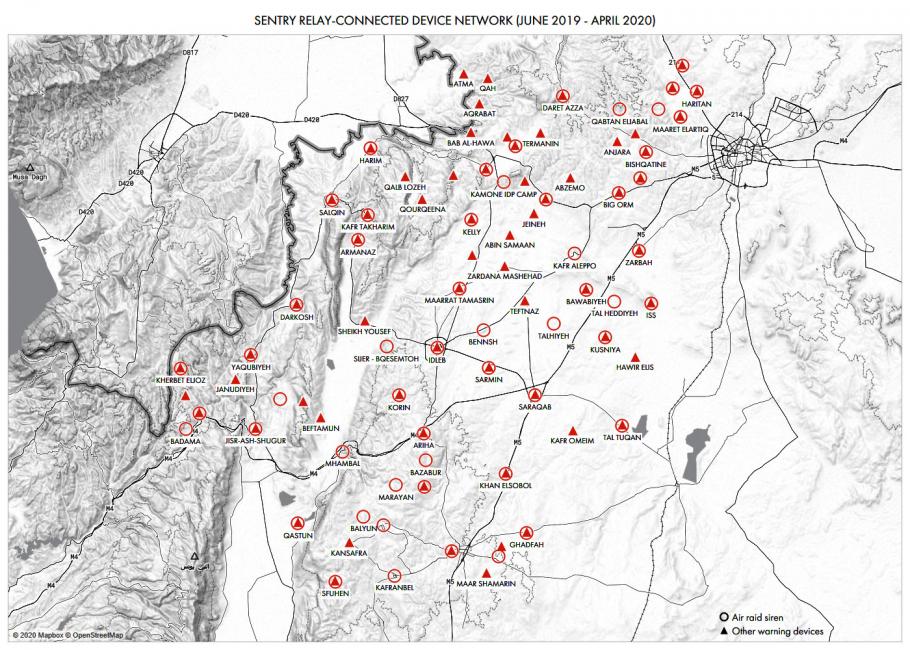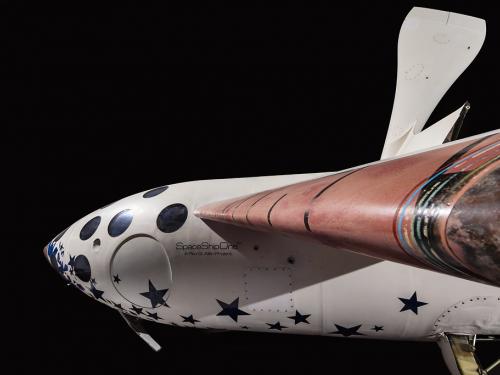Three Hala Sentry System Artifacts Will Be on Display in Living in the Space Age
Apr 13, 2023
By James David
The Smithsonian’s National Air and Space Museum recently acquired three Hala Sentry System artifacts—a red warning light, a communications relay device, and an acoustic sensor. They will be displayed in the upcoming Raytheon Technologies Living in the Space Age gallery when it opens in a few years. Hala Systems Inc. donated the objects to the Museum.
Acoustic sensor (l), red warning light, and communications relay switch. (Image courtesy of Hala Systems, Inc.)
The company developed the Sentry system beginning in 2015 to provide early warning of air attacks by the Syrian government and Russia to people in Sunni–opposition-controlled areas of Syria. Because the country is small and many of these areas are not far from government airfields, aircraft often arrive at the target very quickly and as a result, there is little time for warnings. The air strikes have delivered conventional munitions and, at times, even chemical weapons on mostly civilian targets, such as medical facilities, markets, schools, and residential areas. They are responsible for tens of thousands of fatalities.
Hala Sentry Systems lights installed in health clinic in opposition-controlled area of Syria. (Image courtesy of Hala Systems, Inc.)
The Hala Sentry System relies on two main sources of information for issuing warnings. First, Syrian volunteers covertly observe and report via a smartphone app their location and the direction and types of aircraft being launched. This is a dangerous task as government forces are constantly looking for people who assist the rebels in any way. Second, it utilizes battery-powered acoustic sensors. Housed inside of them is a small array of microphones that capture critical sound data from planes passing overhead. The acoustic sensors have been improved over time and currently can identify the types of airplanes and gauge their speed and direction. Wind brushes on the top are simple wind screens to refine the sound as it is being recorded. The data from the individuals and acoustic sensors is transmitted by one of several means, including communications satellites, to a Hala server outside the country.
Using algorithms developed by the company, the server compares the information received to data from previous attacks. It quickly calculates the chances of an air strike and determines the likely targets and time of arrival over them. The system has constantly been improved, and now the predictions of the time of arrival are accurate to within 30 seconds. Utilizing communications satellites or other methods, warnings are then immediately sent through social media to these areas and signals are transmitted through the communications relay devices to activate alert systems. These alert systems include pre-existing air raid sirens, which were built to be manually operated. Since this procedure was too slow to give warnings, Hala developed a component that was added to the sirens and enabled them to be activated remotely. Alert systems in medical facilities include red warning lights and buzzers.
Hala Sentry System warning network in Syria, 2019-2020. (Image courtesy of Hala Systems, Inc.)
When the Hala Sentry System began operations, the Sunni opposition groups controlled large swaths of northern, central, and southern Syria. However, massive Russian and Iranian assistance, including combat forces, have helped the government regain much of the lost territory. By 2022, these rebel groups were pushed back to Idlib province in the northern part of the country and a largely unpopulated area along the southern border with Jordan and Iraq. Many of the areas Hala Sentry Systems used to serve are under government control now. Today, it operates primarily in Idlib province and an adjoining buffer zone.
Since it began operations, Hala Sentry System has issued an average of 140 warnings a day in areas where several million people have resided. Without question, the warnings have prevented many thousands from being killed or wounded. The system has also provided evidence of over 75 war crimes associated with air strikes and disseminated more than 250 reports of Syrian and Russian aircraft violations of ceasefires to governments, non-governmental organizations, and the United Nations.
Related Topics
You may also like

Support the Museum
We rely on the generous support of donors, sponsors, members, and other benefactors to share the history and impact of aviation and spaceflight, educate the public, and inspire future generations. With your help, we can continue to preserve and safeguard the world’s most comprehensive collection of artifacts representing the great achievements of flight and space exploration.
Support the Museum
We rely on the generous support of donors, sponsors, members, and other benefactors to share the history and impact of aviation and spaceflight, educate the public, and inspire future generations. With your help, we can continue to preserve and safeguard the world’s most comprehensive collection of artifacts representing the great achievements of flight and space exploration.




